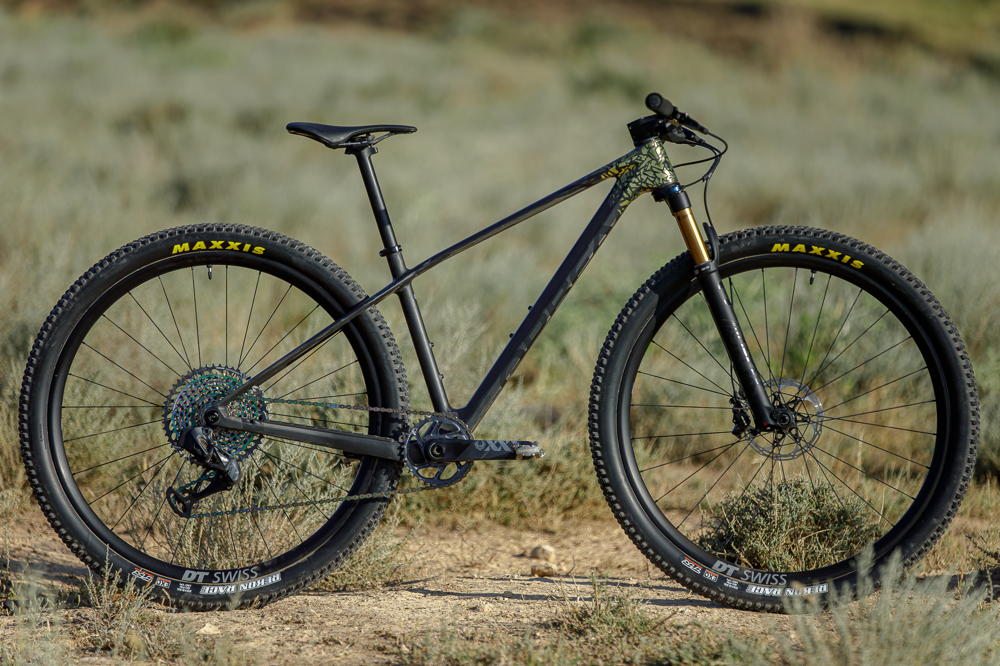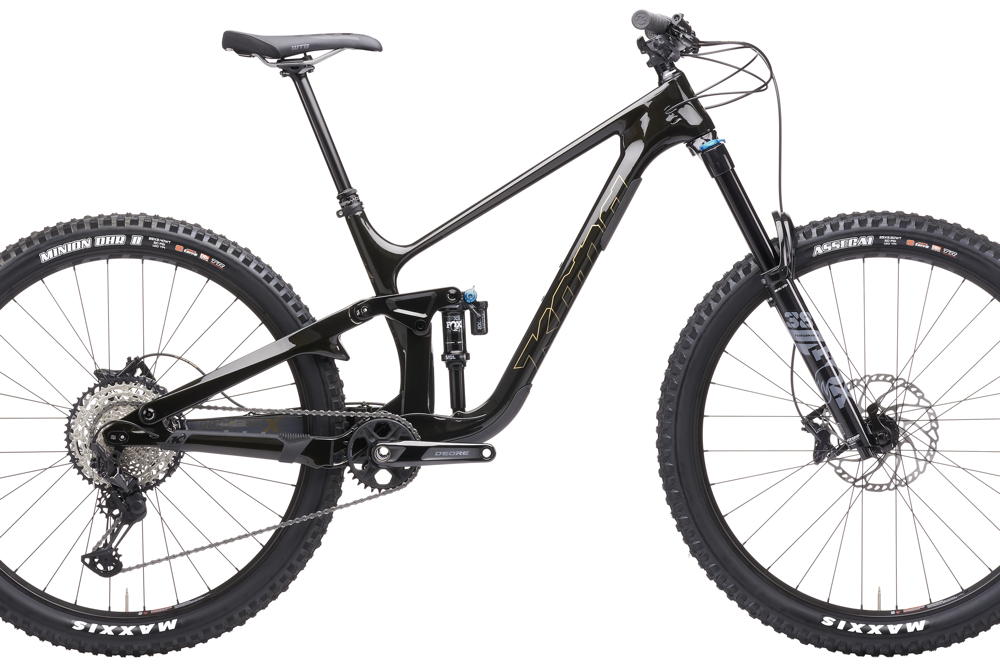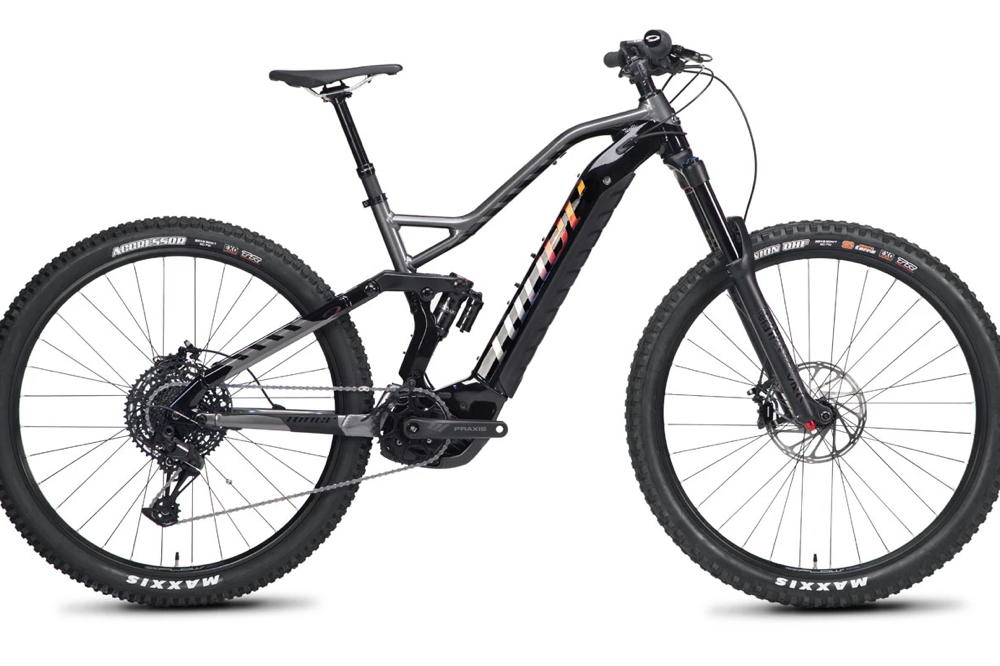Ultralight racing snakes, bargain full-sus, quieter, lighter, more efficient e-bikes. With trends like these, there's lots to look forward to in 2021.
The world is awash with brand new bikes and fresh models – we ride a clutch of new XC race bikes, some revised enudro bikes and next generation ebikes.
Read more: Best mountain bike 2020 – all you need to know
XC bikes: when speed is everything

Orbea Alma
With the Alma, Spanish brand Orbea has redesigned its XC race whippet with a new frame, new graphic options, and – if you’re hard enough – a rigid fork. It’s still very much a race bike in the traditional mould, with a steep head angle (relaxed by 1.5º to 68º) and a feather-light frame that’s all about saving grams. By looking closely at all the fittings, examining the lay-up and moving to Orbea’s halo OMX carbon material, the frame weight has been reduced by 120g to 830g (claimed) for a size medium.
Up front, the Alma is designed around a 100mm suspension fork or the updated Spirit rigid fork. Yes, if you want the ultimate weight saving and can take the pummelling, this ultralight (500g) fork will certainly turn heads.
As with all Orbeas, there’s the chance to customise your bike through the MyO portal. On the lower price models it’s just components that can be changed, but the M-Ltd, M-Team and M-Pro let you choose colours, graphics and components to create your dream bike.
Read more: Best XC race bikes – hardtail and full suspension

BMC Twostroke
BMC has bought a new ruler, and it’s been pressed straight into action designing the angular Twostroke hardtail. While swoopy curves are in short supply, we think the end result looks fantastic and marks a welcome change from the tall, level top tubes of older generation BMCs. The Twostroke also breaks with BMC tradition by adding a trail-friendly 67º head angle (this is an XC race bike remember) and plenty of tyre clearance for grippy rubber. BMC has neatly integrated the entry ports for the internal cable routing with the steering stop that protects the down tube from the fork crown in a crash, and there are flattened seat stays and a 27.2mm seatpost with the aim of bringing a modicum of comfort to the rear end. Both carbon and alloy frames are offered in four sizes, with reach measurements from 422mm to 485mm. And as for the weight, BMC claims to have limbo-ed under the crucial 10kg barrier, with its top end Twostroke One coming in at 9.52kg.

Trek Procaliber
This year Trek introduced the striking Supercaliber and its integrated IsoStrut shock with the aim of bridging the gap between hardtail and full-suspension for XC racing.

Decoupler survives the 2021 revamp
For 2021 it has turned its hand to the Trek Procaliber – its World Cup hardtail and mbr 10/10 test winner – refining the geometry and focussing the wheel size. The new Procaliber now adopts the same silhouette as its fully-suspended sibling, allowing its team riders, and well-heeled privateers, to switch between models more easily for different courses.

A classy rig never scrimps on aesthetics
It still gets the IsoSpeed decoupler that gives the seat tube the freedom to move a little when seated over those annoying little bumps that interrupt your pedal stroke. And in a move that reflects the trend in most echelons of racing, it’s now only available with 29in wheels – previous versions used 27.5in wheels on the smaller frames.

Mondraker Podium
The XC weight wars are intensifying, and Mondraker is the latest brand to step off the scales and claim the title of lightest production mountain bike frame currently on sale. Its new Podium is said to weigh a paltry 775g in size medium, that’s 15g lighter than the previous title holder, the Specialized S-Works Epic HT.
Mondraker’s World Cup-ready hardtail also gets some subtle tweaks for 2021. Aside from a new lay-up using high-modulus carbon fibre, the frame sports new geometry and sizing to reflect a more progressive attitude to fit and handling than many of its competitors. The head angle is now 68.5º, the effective seat angle is a claimed 74.5º and the chainstays are 430mm.
There are four frame sizes from Small to XL and the reach measurements go from 390mm to 510mm. All four Podium models get the new super-light frame, with prices starting at £3,799 for the Podium Carbon.
Trail and enduro bikes: flatten the ascents, rail the descents

Polygon Siskiu T7
The Calibre Bossnut has redefined the entry-level full-suspension market by combining astounding value with carefully tuned suspension, capable geometry and a spec that ticks all the right boxes. Unfortunately it’s a victim of its own success, and actually getting hold of one is as easy as mining for bitcoin.

The Siskui can go toe-to-toe with the Bossnut
Possible solace comes from in the shape of the new Polygon Siskiu, which, spookily, uses an almost identical frame to the Bossnut. That’s because Polygon makes frames for Calibre, and while its own offerings have previously lagged behind the Bossnut, this new version looks to have caught up. There are five frame sizes, the smallest two of which come with 27.5in wheels, and the rest with 29in wheels. We’re pleased to see modern geometry too, with a 65º head angle, reach that ranges from 440mm to 500mm and a steep 76.5º effective seat angle. Two models are available, both with 140mm of travel and an alloy frame, and for €1,799 this lower-priced T7 gets a dropper post, RockShox Recon fork and Deluxe shock, short stem, wide bars and 12-speed Deore groupset.

Kona Honzo ESD
Kona’s Honzo is a leftfield model from a mainstream brand. This cult hardtail gets a steel frame and raked out angles designed to appeal to the renegade ripper. Up front there’s a short offset Marzocchi Z1 Bomber fork, sloping away from you at a chilled 63.5º. Reach on the four frame sizes ranges from 440mm to 525mm, while the standover actually drops by 6mm on the XL versus the Small. With a steep 77.5º seat angle, climbing shouldn’t be too much of a chore, leaving you with more energy to expend slashing and boosting your way down the freshest loam tracks.

Giant Trance X
Another bike to get an X appendage is the Giant Trance. The Taiwanese brand’s venerable trail bike, and recent MBR test winner, has been boosted in this configuration by 20mm of travel, bringing the rear to 135mm and the fork to 150mm.

Easy geometry tweaks via a flip-chip
Our main criticism of the 2020 Trance was conservative sizing, so it’s great to see that the new Giant Trance X addresses that with considerably longer reach measurements across all frame sizes. Only available with an alloy frame, the Trance X also benefits from a new flip-chip in the rocker link to let you play with the head angle and BB height. It gives a useful 10mm change to the latter and around 0.7º of head angle adjustment. Look out for a first ride soon.

Kona Process X
This generation X is the longest travel Kona Process to date, with 161mm of rear travel paired with a 170mm travel fork up front. There are two models offered: the £5,499 Process X and the flagship £7,299 Process X DL. Both bikes get carbon frames and roll on 29in wheels, although there’s a flip-chip in the rocker link that enables a 27.5in wheel to be run out back.

Flip-chip affords wheel-size options
And the adjustability doesn’t end there. Kona has also added adjustable chainstays, giving you the option of running one of two different rear centre lengths (435mm or 450mm). Essentially the Process X is Kona’s full-on Enduro World Series-worthy bike, where 160mm travel 29ers are the weapon of choice.
Kona has always had pretty progressive long ‘n’ low ‘n’ slack geometry, and the Process X continues this theme. The head angle is 63.5°, the seat angle is 77.5°, and the seat tubes are impressively short, affording the ability for all rider heights to run longer length dropper posts (S-M get 170mm posts, L-XL get 200mm posts).
Read more: Best enduro mountain bikes in 2020 – 150 to 170mm travel full suspension bikes

Bird Aether 9C
UK-based direct-sales brand, Bird, has just unveiled its first carbon bike; the Aether 9C. Referring to the fifth element, or life force, the Aether 9C runs a very down-to-earth combination of 29in wheels and 130mm of travel, but reaches out into the unknown with its radical 541mm reach on the size XL frame. Yes, this is no flat-earther in terms of sizing, and also gets size-specific seat angles. This aims to help taller riders with longer legs stay centred over the BB with their saddles at full extension. Smaller frames get slacker angles and larger frames ramp up to 78º.
The full carbon frame (including carbon stays) gets full internal cable routing, room for a full-size bottle in the front triangle, threaded BB and integrated chainstay and down tube protection.
E-bikes: boost your fun

Yamaha YDX-MORO
We first saw glimpses of a Yamaha e-bike back in October last year and now the Japanese powerhouse has revealed the finished product. It’s called the Yamaha YDX-MORO and it gets 160mm travel, a distinctive, motorcycle-inspired, aluminium frame and the brand’s own PW-X2 motor.

Own-brand motor uses a tilt-sensor to identify steep stuff
The eye-catching ‘split’ frame tube design of the show bike has been retained. Both the top tube and the down tube comprise of two struts that cradle the shock and the battery.

Head unit offers a wealth of feedback
This split-tube design has been chosen not just to stand out from the crowd; Yamaha claims there are structural and ride handling reasons for making the frame in this way. It affords a lower standover and shorter seat tube height, the split down tube allows the battery to be positioned a little lower and more centred in the bike for improved handling characteristics, and means the motor can be angled (clocked) slightly to help bring in the chainstay length a little (although the chainstays are still pretty long at 460mm). Yamaha also claims the design increases chassis stiffness in the middle of the bike too, and, on a more practical note, it’s just easier to get the battery out for recharging duties.
The PW-X2 motor generates up to 80Nm of torque, but you can only access this in EXPW mode. Also offered are Eco, Standard, High, a new MTB mode. There’s also a Walk mode. The PW-X2 motor sports a Quad Sensor System. This essentially adds a clinometer-style tilt-sensor to the mix, so that the motor can tell if you’re riding uphill – and at what severity of gradient. This fourth sensor joins the PW-X’s previous three sensors (pedal cadence, pedal torque, rolling speed) and thus has the ability to offer ‘automatic’ or ‘intelligent’ power modes.
Read more: Best electric mountain bikes – all you need to know

Kona Remote 160 DL
Kona’s big hitting e-bike gets updated for 2021 with the new Shimano EP8 motor, bringing more power and less noise. It also gets 29in wheels (last year’s Remote Control and the new Remote 160 run on 27.5in wheels), but the internal battery (504Wh) remains, as does the rocker link actuated shock and faux-bar, single-pivot linkage.

Rocker-link activated shock stays put for the 2021 model
Big news up front is the addition of the burly RockShox Zeb fork with its 38mm stanchions, and Kona has thoughtfully specced Maxxis Assegai tyres with reinforced EXO+ casings. 160mm of travel too much for you? Well Kona has also introduced the new Remote 130 with 140/130mm of travel and 29in wheels. Here you get a more trail-focussed build and cheaper Shimano E7000 motor paired with a 504Wh internal battery.

Niner RIP e9
29er specialists (well, until it came out with a 27.5in wheel bike) Niner Bikes has rolled into the motor-assisted ring with its first e-bikes. There’s a big-hitting model with 180mm of travel called the WFO e9, and the bike shown here, the 150mm travel RIP e9. Both are powered by Bosch Performance Line CX motors and get internal 625Wh batteries.

RIP e9 gets 150mm travel
Niner has opted to test the water with alloy frames, but we can see it expanding into carbon versions further down the line if there’s enough demand. Using a four-bar suspension layout with a rocker link and trunnion-mount shock, the frames get a distinctive interrupted seat tube and hunchback top tube to make room for a bottle cage. While the RIP e9 uses 29in wheels front and rear, Niner has sensibly opted for a mullet configuration on the WFO e9.



